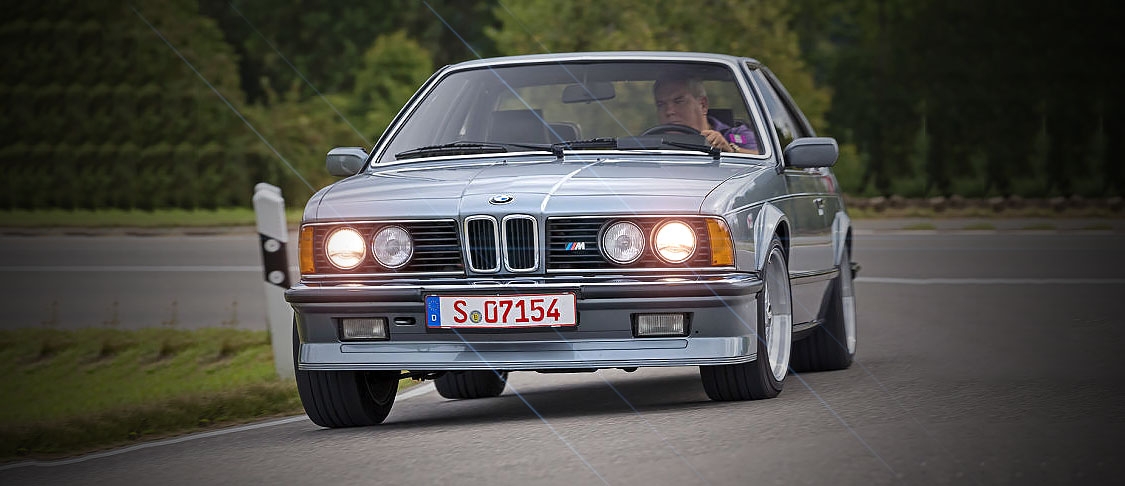
BMW’s M6 E24 flagship costs £34,000 and tops 150 mph but, at a glance, looks no different from the company’s £7000 cheaper 635 CSi. The image may be underplayed; the ability, however, is huge.
BMW M1 E26, M3 E30, M5 E28: it’s a strange irony that BMW should have named its fastest road cars after British motorways blighted by a 70 mph speed limit. “M” in BMW-speak, of course, means “Motorsport” the division of the Bavarian car maker that goes racing and in 1978, created the superb but short-lived M1 supercar in an attempt to clean up in Group 4/5. Alas, it never did, though the exposure of fame was assured with the invention of the M1 Procar series, a spectacular one-make supercar Challenge for racing drivers that warmed up the crowds before World Championship Grand Prix rounds in the early ’80s.
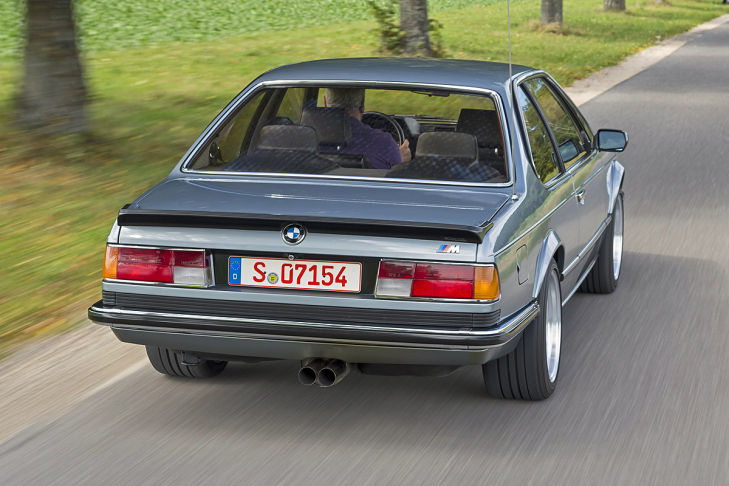
The attrition rate in those races was formidable. But the BMW M1 E26 survived as a landmark: not just because it was very nearly the best car BMW never made — the whole project was jeopardised when build-partners Lamborghini pulled out at the prototype stage — but because the technology embodied in the M1’s fabulous 24-valve twin-cam “six” sired a whole range of superfast M-cars. The deceptively-named M535i E28, incidentally, is not one of them, nor has it ever been. Both in series 1 and 2 guises it goes down in the record books as a factory shoe-horn special, mating the standard 3.5-litre single overhead cam straight six with the standard E28 5-Series bodyshell. With these cars, the Motorsport influence was purely cosmetic.
| MAXIMUM SPEEDS AT TEST | |||
| Gear | mph | kph | rpm |
| Top (mean) | 149.7 | 240.9 | 5.950 |
| (best) | 151.0 | 243.0 | 6.000 |
| 4th | 133 | 214 | 6.300 |
| 3rd | 99 | 159 | 6.350 |
| 2nd | 64 | 102 | 6.350 |
| 1st | 38 | 61 | 6.350 |

The E24 M635 CSi we test here, however, was both designed and developed by the Motorsport divsion, even though it rolls off BMW’s regular production lines. The M5 E28 and M3 E30 — neither of which is yet on sale in the UK — are built by Motorsport just down the road from BMW’s HQ in Munich. Launched in 1983, some two years after the E26 M1 ‘s demise, the M635 (since nicknamed the E24 M6) inherited a modified version of the E26 M1’s 3453 cc engine. Digital Bosch Motronic fuel injection replaced the mechanical system and small modifications to the twin-cam, four-valves-per-cylinder head improved breathing efficiency. The result: maximum output raised by nine horses to 286 bhp at 6500 rpm and peak torque up from 239 lb ft at 5000 rpm to 251 lb ft at 4500 rpm. Set against the 218 bhp and 229 lb ft of the cooking 635 CSi, the M-car’s performance potential is on a higher plane altogether.
| ACCELERATION FROM REST | |||
| mph | sec | kph | sec |
| 0-30 | 2.7 | 0-40 | 2.4 |
| 0-40 | 3.7 | 0-60 | 3.7 |
| 0-50 | 4.6 | 0-80 | 5.1 |
| 0-60 | 6.3 | 0-100 | 6.7 |
| 0-70 | 8.1 | 0-120 | 9.1 |
| 0-80 | 10.0 | 0-140 | 11.7 |
| 0-90 | 12.2 | 0-160 | 15.1 |
| 0-100 | 15.2 | 0-180 | 19.7 |
| 0-200 | 25.5 | ||
|
0-110 |
18.6 | Standing 1 km | 26.6 |
|
0-120 |
14.9 | ||
| Standing ¼ mile | 14.9 | ||
| ACCELERATION IN TOP | |||
| mph | sec | kph | sec |
| 20-40 | 9.4 | 40-60 | 5.7 |
| 30-50 | 9.3 | 60-80 | 5.6 |
| 40-60 | 9.2 | 80-100 | 5.4 |
| 50-70 | 9.0 | 100-120 | 5.5 |
| 60-80 | 9.1 | 120-140 | 5.7 |
| 70-90 | 9.6 | 140-160 | 6.3 |
| 80-100 | 9.8 | 160-180 | 6.9 |
| ACCELERATION IN 4TH | |||
| mph | sec | kph | sec |
| 20-40 | 6.7 | 40-60 | 4.2 |
| 30-50 | 6.7 | 60-80 | 4.1 |
| 40-60 | 6.6 | 80-100 | 3.8 |
| 50-70 | 6.1 | 100-120 | 3.7 |
| 60-80 | 6.0 | 120-140 | 3.5 |
| 70-90 | 6.1 | 140-160 | 3.6 |
| 80-100 | 6.2 | 160-180 | 4.2 |
| 90-110 | 6.6 | 180-200 | 5.6 |
| 100-120 | 7.8 | ||
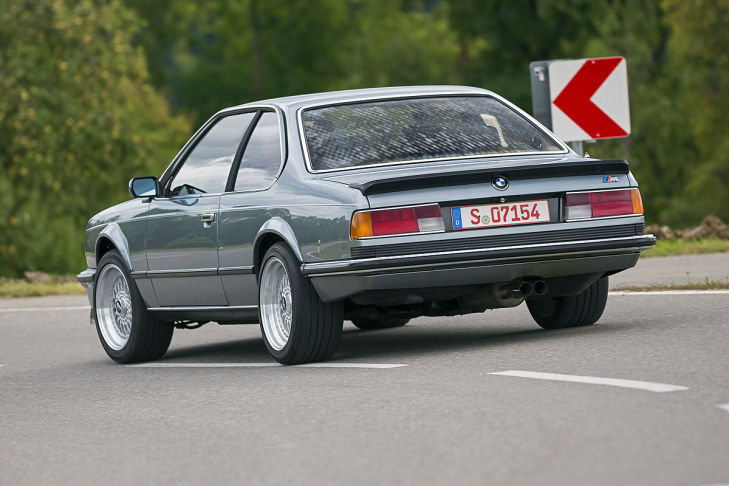
Not that there are many visual clues. To say that the M6 is understated is itself an under-statement. For a car that has assumed the M1 ‘s supercar status and, with a £34,000 price tag, is pitched right in the laps of Porsche, Ferrari, Jaguar and Mercedes, it might well be argued that fine-lattice style BBS alloy wheels with wide Michelin TRX tyres, a slightly deeper nose spoiler, colour-keyed door mirrors and two oh-so-subtle grille and boot-mounted Motorsport emblems provide insufficient visual distinction — too much sheep and not enough wolf. Then again, the cognoscenti will know that the M6 E24 is capable of well over 150 mph and of accelerating from rest to 60 mph in a shade over 6 seconds. When you’ve got it, you don’t necessarily have to flaunt it. Those inclined to dismiss a shape that’s been around for the best part of a decade do so at their own peril.

We knew the E24 M6 was Ferrari-fast when we strapped our fifth wheel to an early left-hand drive example in Germany and published our findings in Motor w/e November 12, 1983. At that time, there were no plans to make a rhd version for the UK, but so strong was demand that BMW relented this spring, reporting firm orders for well over half of the 200 rhd cars earmarked for the UK market in 1985. Back in 1983 we predicted a price of £30,000 for the M6 if it ever reached these shores: the reality is a hefty £33,875, though this includes a long list of equipment not found as standard on the German-spec cars — the extra-wide 210 mm BBS wheels and 240/45 VR 15 tyres and electrically powered sunroof, for instance. Even so, the E24 M6 finds itself up against some redoubtable machinery, in the shape of other superfast two-plus-two coupes like the Mercedes-Benz 500 SEC C126 (W126-based coupe – just superseded on the German market by the 560 SEC but still available in the UK at £37.065), the Jaguar XJ-S HE (nearly £10,000 cheaper at £23,995), the Audi Quattro (£23,273) the Ferrari Mondial Quattrovalvole (£33,200), and Porsche 928 S II (£35,524).
| FUEL CONSUMPTION | ||
| Overall | 16.9 mpg 16.7 litres/100 km | |
| Touring* | 24.0 mpg 11.8 litres/100 km | |
| Govt tests | 17.1 mpg (urban) 34.4 mpg (56 mph) 27.7 mpg (75 mph) | |
| Fuel grade | 97 octane | |
| 4 star rating | ||
| Tank capacity | 70 litres | |
| 15.4 galls | ||
| Max range* | 370 miles | |
| 595 km | ||
| Test distance | 517 miles 832 km | |
| Based on official fuel economy figures – 50 per cent of urban cycle, plus 25 per cent of each of 56/75 mph consumptions. | ||
| STEERING | ||
| Turning circle Lock to lock | 10.8 m 35.6 ft 3.2 turns | |
| NOISE | dBA | |
| 30 mph | 67 | |
| 50 mph | 70 | |
| 70 mph | 74 | |
| Maximum level | 80 | |
| Peak noise level under full-throttle acceleration in 2nd | ||
| Distance recorder: 1.4 per cent slow | ||
| WEIGHT | kq | cwt |
| Unladen weight* | 1506 | 29.6 |
| Weight as tested | 1708 | 33.6 |
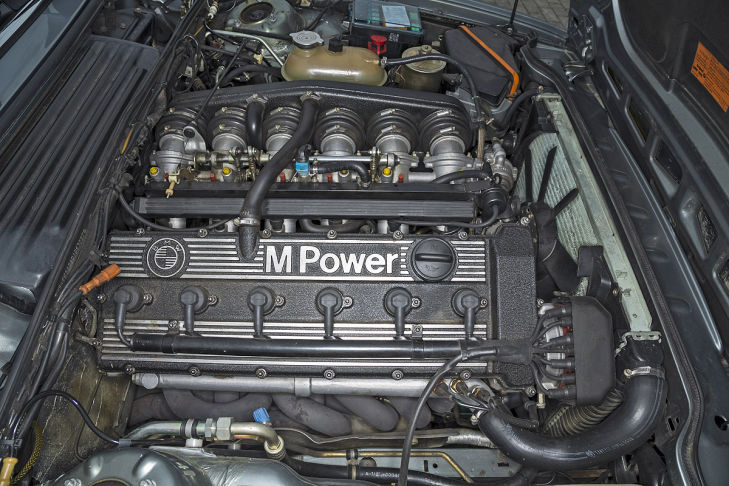
Rare M88/3 engine. Left: one of the world’s great production engines beautifully presented.
In view of the weight of ability and charisma stacked against it, we decided to re-test the M6 on our home ground. At Millbrook as in Germany, the M-car’s performance was mighty though, as expected, the effects of tyre scrub knocked about 4 mph off the top speed, dropping it from 154.1 mph to 149.7 mph. On the basis that the autobahn figure is a true reflection of the BMW’s top-end potential, however, it ranks with the very fastest cars in its class. Even comparing the BMW’s Millbrook top speed with those of rivals tested at Millbrook, none is faster, though it has to be borne in mind that the Porsche (149.1 mph) was tested in automatic form: with a manual gearbox, it should just shade the M6 E24. But such hair-splitting is academic: 150 mph is fast enough.
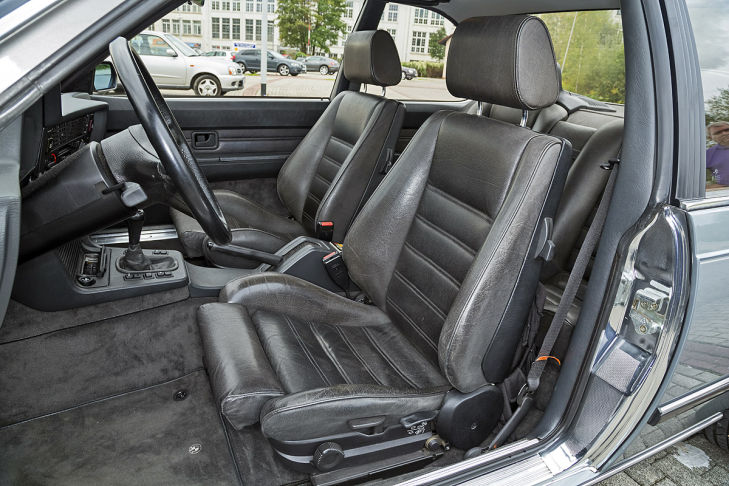
The BMW clearly has a surfeit of power over traction. Even with the best efforts of the fat Michel- ins, it left the line at Millbrook in a haze of tyre smoke to reach 60 mph in just 6.3 sec — 0.1 sec better than the Ihd car managed in Germany — and on to 100 mph in an even more impressive 1 5.2 sec, a figure some 3.1 sec better than that for the cooking 635. Only a handful of the world’s supercars are significantly quicker over these benchmarks though there is a dense concentration of machinery that gets close. Only fractions separate the BMW from the Ferrari (6.4 sec), the Porsche (6.5 sec) and the Audi (6.5 sec) in the sprint to 60 mph, for instance. Few rivals, however, can match the sheer breadth of the BMW’s power band: in fourth, it covers each of the 20 mph increments between 20 and 1 10 mph in 61/2 sec or less. In fifth, the increment times between 20 and 90 mph are disposed of in around 9.5 sec apiece: the 24-valver has real strength in depth.
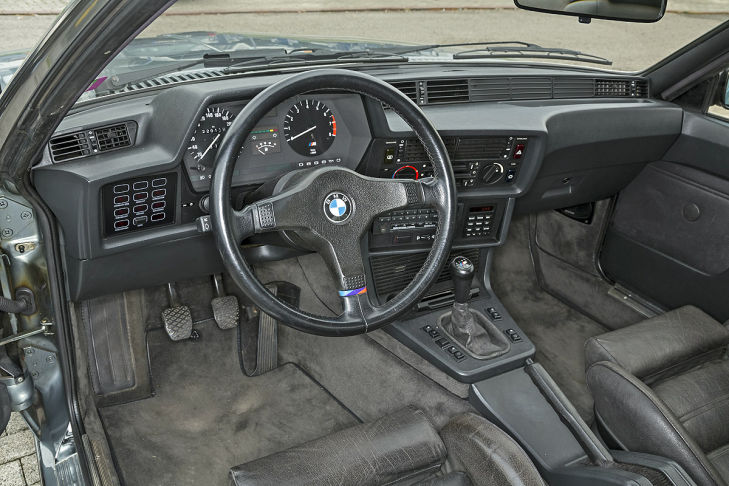
Above: the quintessential BMW facia — clean, understated, ergonomically correct, if conventional. Left: for clarity, instruments rank among the best. Above left: front seats are hard but properly supportive, adjustable for height, rake, reach and thigh support. Above: despite inviting looking buckets rear legroom is minimal.
And that’s the way it feels on the road: it’s one of the few engines that can combine a solid low-speed punch with genuine free-revving fury. Its power is impeccably delivered, too, with sabre-edged throttle response and a complete lack of temperament in traffic. Outstanding tractability is another facet of this remarkable engine, full throttle being accepted from just 600 rpm in fifth without a tremor of protest. The crowning glory, however, is aural. For a unit with a 24-valve head, mechanical refinement is exceptional all the way to the 6900 rpm red-line. Nor has smoothness been compromised: in this respect, the M-car’s engine is as silken as any BMW’s. The difference is a subtle one, the well-bred hum that is a BMW trademark hardening and deepening with revs until full throttle unleashes a spine-tingling howl that, while far from loud, is delectable in its sophisticated quality.

Porsche. Lotus and others have shown that hard muscle and a gentle thirst aren’t necessarily mutually exclusive. Inasmuch as our M6 returned just 16.9 mpg overall, then, it is rather old-fashioned. Even so, it’s unlikely that potential customers will view this too gravely in the light of the BMW’s storming performance. If pricked by barbs of social conscience, however, the customer might find that Ferrari’s 18.6 mpg Mondial avoids sleepless nights. With a large dose of restraint, our projected touring figure of 24.0 mpg is certainly on, giving a potential maximum range of 370 miles on a 70-litre tankful of 4-star.
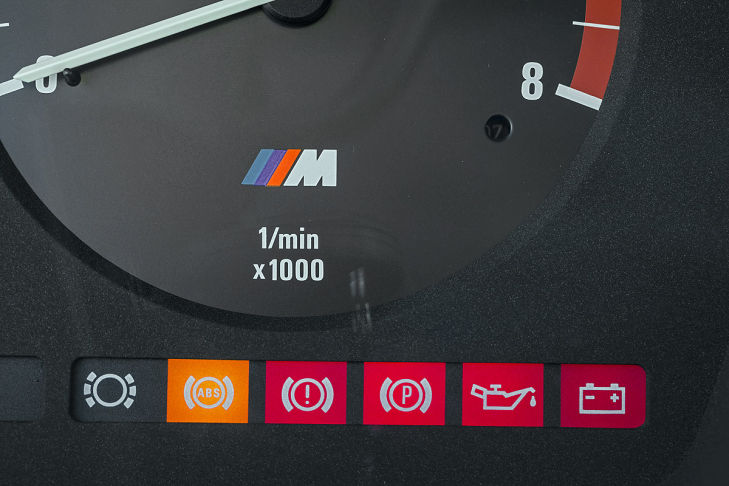
The M6 has a heavy clutch but a delightfully light and easy gearchange. The five-speed Getrag gearbox is notable for its speed and precision and urges more frequent gear-changing than is strictly necessary. The intermediate ratios are long but closely spaced, allowing maxima of 38, 64, 99 and 133 mph at 6900 rpm. Second, in particular, is a superb overtaking gear, enabling the engine to deliver scintillating acceleration to just under the legal limit.
On first acquaintance, the big BMW’s handling seems less than special. The assisted recirculating ball steering feels low-geared, a mite heavy and lifeless; initial turn-in isn’t as crisp as the taut, nuggety low-speed ride might lead you to believe. Yes, the E24 M6 even verges on the ponderous around town.
But then it was never made to be enjoyed in an urban environment. With increasing pace comes more articulate communication and lucid responses. Steering that seemed dead suddenly shows more than a glimmer of life: steady and smoothly coordinated hands are now required on the helm for jerky inputs are faithfully transmitted to the front wheels. There the fat Michelins bite hard, holding understeer tightly in check. Squeeze the throttle firmly and the M6 points more directly still. In fast sweeps, chassis balance is simply superb, the cornering attitude remaining neutral for far longer than with the cooking 635. The 25 per cent limited slip differential, up-rated gas-filled dampers and tauter springs help tame the rear semi-trailing arms’ natural predilection for oversteer, restricting camber angle changes under power and on lift-off. When the tail does drift out of line it is to the command of the throttle and in accordance with the driver’s wishes: it can be held or cancelled at will. Nor is the BMW’s composure unduly upset by mid- corner bumps. As with the ride, control is the key — firm but never harsh. For sheer power, the brakes measure up to the high dynamic standards the E24 M6 sets itself. For feel and progression, however, they disappoint, the pedal feeling dead and “wooden” underfoot, characteristics BMW seems unable to get out of its Bosch ABS-equipped cars.
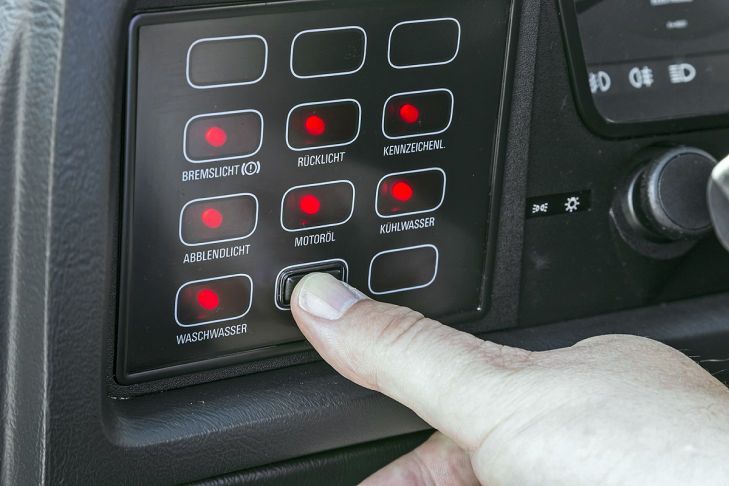
Mechanically, the M-car is no noisier than the ordinary BMW 635i E24 but its fatter tyres do rumble more over coarse surfaces. A pity, because wind noise is very low. For the rest, the E24 M6 is almost pure 6-Series coupe, a car that has been featured numerous times in these pages. The interior is essentially roomy for two people, though tall drivers will run out of headroom, despite the height adjustment offered by the front seats; the rear accommodation is strictly “occasional”. Instrumentation is comprehensive and beautifully clear, switch-gear ergonomics every bit as good as the driving position and the relationship between the major controls. The M6 E24-series, like its cheaper counterpart, has one of the best heating and ventilation systems in the business and retains the useful Service Interval Indicator and on-board computer. If you can come to terms with sitting in a cabin that looks and feels no different from that of the £7000 cheaper E24 635 CSi, it’s easier to appreciate the first-class standard of build and finish. Much the same goes for the outside, too.
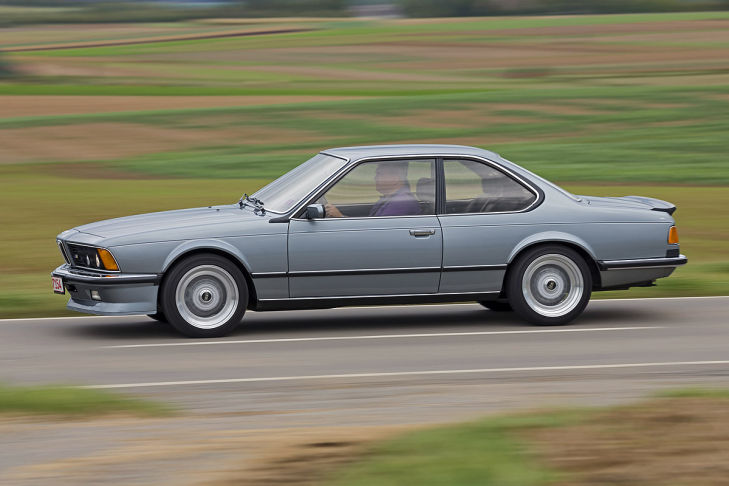
But if that bothers you then the M6 isn’t your sort of car. It’s a car that doesn’t wear its mighty heart on its sleeve. The essence of the M6 is tangible rather than visible — its pace and dynamic virtuosity. It’s too thirsty and, by some measure, too expensive. But genuine Grand Touring cars of the BMW’s ability are becoming all too rare. For those who can appreciate what it has to offer, the price is merely an obstacle.
The M6 has only a handful of real rivals. We detail them below with 1985 price.
BMW M635 CSi E24 £33,875
Fastest BMW available in the UK takes the decade-old 6-Senes firmly into supercar territory and more than holds its own. Fabulous 24-valve six delivers stunning performance with good refinement but is very thirsty Handling is both enjoyable and forgiving, ride firm but well-controlled. Interior is too ordinary for £34.000 but build and finish are first class. Generally well equipped but air conditioning is extra.
Audi Quattro £23,273
A more civilised machine these days than its epoch-making predecessor, the 4wd Quattro is more than ever a milestone in car design. It combines phenomenal roadholding and traction with performance, refinement, economy, comfort and accommodation in a way that has no equal, against which its weaknesses — poor ratios (still) and slow shift, unprogressive heating, sparse instruments — are minor failings. Now available with anti-lock braking.
Ferrari Mondial QV £33,200
The strictly two-seater 308GTB is a closer rival to the BMW on price, but the Mondial is a token four-seater Quattrovalvole power delivers super-car performance with respectable economy, while other virtues include safe, balanced handling, superb brakes, a comfortable ride and driving position, smooth engine and satisfying gear-change. Low gearing leads to highish noise levels, however, and the heating and ventilation leave something to be desired.
Jaguar XJS 5.3 HE £23,995
Available only in automatic form, and supplied with the May “Fireball” heads, the magnificent V12 XJ-S is now noticeably more economical. As always, it offers an astonishing combination of high performance and refinement. Its handling is less sporting than that of the BMW, but safe and predictable. Styling hasn’t improved with familiarity, and there’s not much room in the rear, but it remains one of the most desirable high-speed expresses.
Mercedes-Benz 500 SEC C126 £37,065
Current flagship of the Mercedes range (New 560 SEC comes to UK next year), the 500 SEC is superbly engineered and impeccably finished Good performance and handling is matched by excellent refinement, a very comfortable ride, and full four-seater accommodation. Only available with a four-speed automatic transmission which has exceptionally high overall gearing but is still responsive and smooth. Very economical for its size and performance.
Porsche 928 S2 £35,524
In its latest form Porsche’s splendid 928S is stunningly quickand respectably economical with its new four- speed automatic transmission. Handling and road-holding superb, and potent brakes now have anti-lock system as standard. Very spacious and comfortable cabin for two (but a cramped 2 + 2). excellent driving position and instrumentation, but ride and refinement not in the Jaguar class. Manual option would be more in keeping with its sporting character.
| Car | 1984 BMW M635 CSi E24 |
| Made in | Germany |
| Car type | Front engine, rear drive |
| Made in | Germany |
| Number built | 5855, include 524 RHD |
| ENGINE | |
| Type | BMW M88/3 |
| Head/block | All alloy head / cast iron block |
| Cylinders | 6, in line |
| Main bearings | 7 |
| Cooling | Water |
| Fan | Viscous |
| Bore, mm (in.) | 93.4 (3.68) |
| Stroke, mm (in.) | 84 (3.31) |
| Capacity, cc (in.) | 3.453 (210.7) |
| Valve gear | DOHC – 24-valve/ 4-valves per cylinder |
| Camshaft drive | Chain |
| Compression ratio | 10.5-to-1 |
| Ignition | Electronic breakerless fully programmed |
| Fuel injection | Bosch Motronic full electronic system |
| Max power | 288 bhp / 210 KW (DIN / ISO) at 6.500 rpm |
| Max torque | 251lb ft / 340 Nm (DIN / ISO) at 4.000 rpm |
| TRANSMISSION | |
| Type | Getrag 5-speed |
| Clutch | Hydraulic, diaphragm spring |
| Gear Ratio | mph/1000rpm |
| Top | 0.81/23.9 |
| 4th | 1.0/19.3 |
| 3rd | 1.35/14.3 |
| 2nd | 2.08/9.3 |
| 1st | 3.51/5.5 |
| Final drive gear Ratio | Hypoid bevel 3.73-to-1 |
| SUSPENSION | |
| Front location | MacPherson strut |
| springs | oil |
| dampers | Telescopic |
| anti-roll bar | Yes |
| Rear location | Independent, semi-trailing arm |
| springs | Coil |
| dampers | Telescopic |
| anti-roll bar | Yes |
| STEERING | |
| Type | ZF Recirculation ball and nut |
| Power assistance | ZF hydraulic |
| Wheel diameter | 14.7 in. |
| Turns lock to lock | 3.5 |
| BRAKES | |
| Circuits | Twin, split front/ front and rear |
| Front | 30 cm / 11 in. dia. ventilated disc |
| Rear | 28.4 cm / 10.7 in. dia. ventilated disc |
| Servo | Vacuum, ABS Bosch system 4-chanels anti-lock |
| Handbrake | Centre lever, rear drum within disc |
| WHEELS | |
| Type | Cast all alloy 210 mm diameter |
| Rim Width | 6 1/2 in. |
| Tyres make | Michelin |
| type | TRX radial tubeless |
| size | 240/45 VR15 |
| pressure | F33 psi, R32 psi |
| EQUIPMENT | |
| Battery | 12V 90 Ah |
| Alternator | 80Amp |
| Headlamps | 110/220W |
| Reversing lamp | Standard |
| Hazard warning | Standard |
| Electric fuses | 19 |
| Screen wipers | Two-speed plus intermittent |
| Screen washer | Electric |
| Interior heater | Water valve |
| Air conditioning | Extra |
| Interior trim | Leather or cloth seats, pvc head-lining |
| Floor covering | Carpet |
| Jack | Screw pillar |
| Jacking points | Two each side, under sills |
| Windscreen | Laminated, tinted |
| Underbody | Paint system. |
| protection | bitumastic. pvc |





